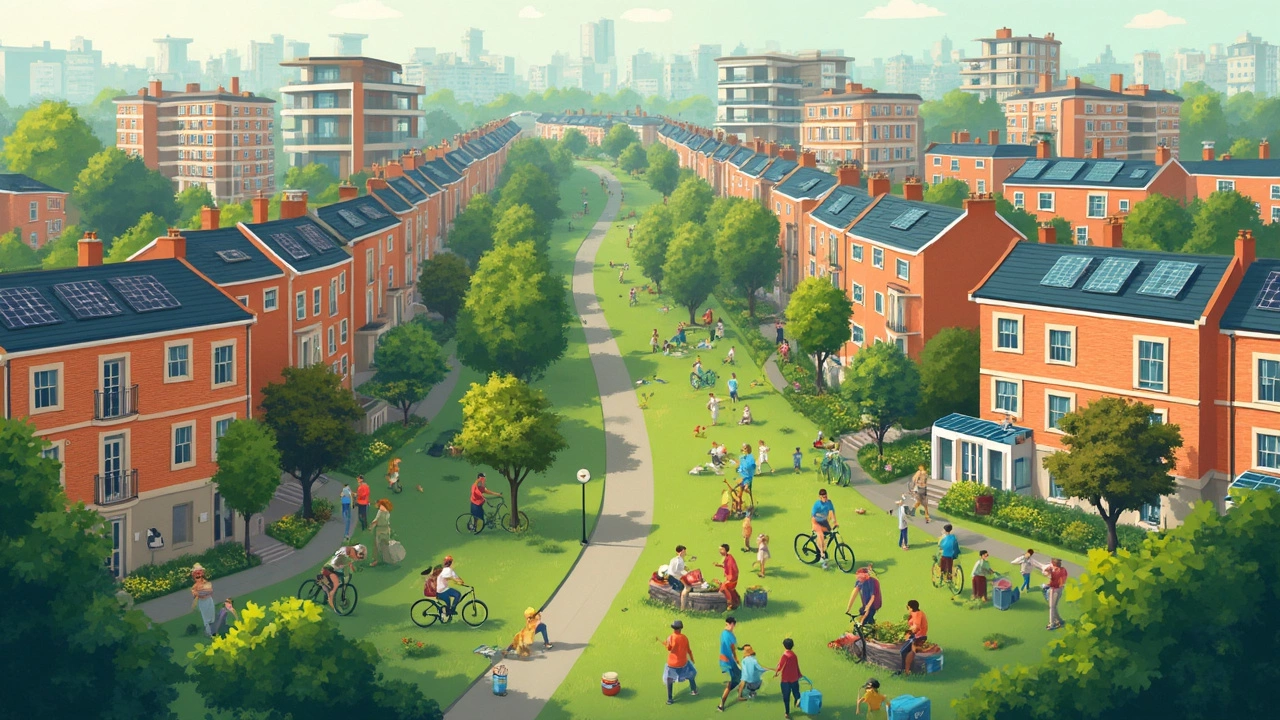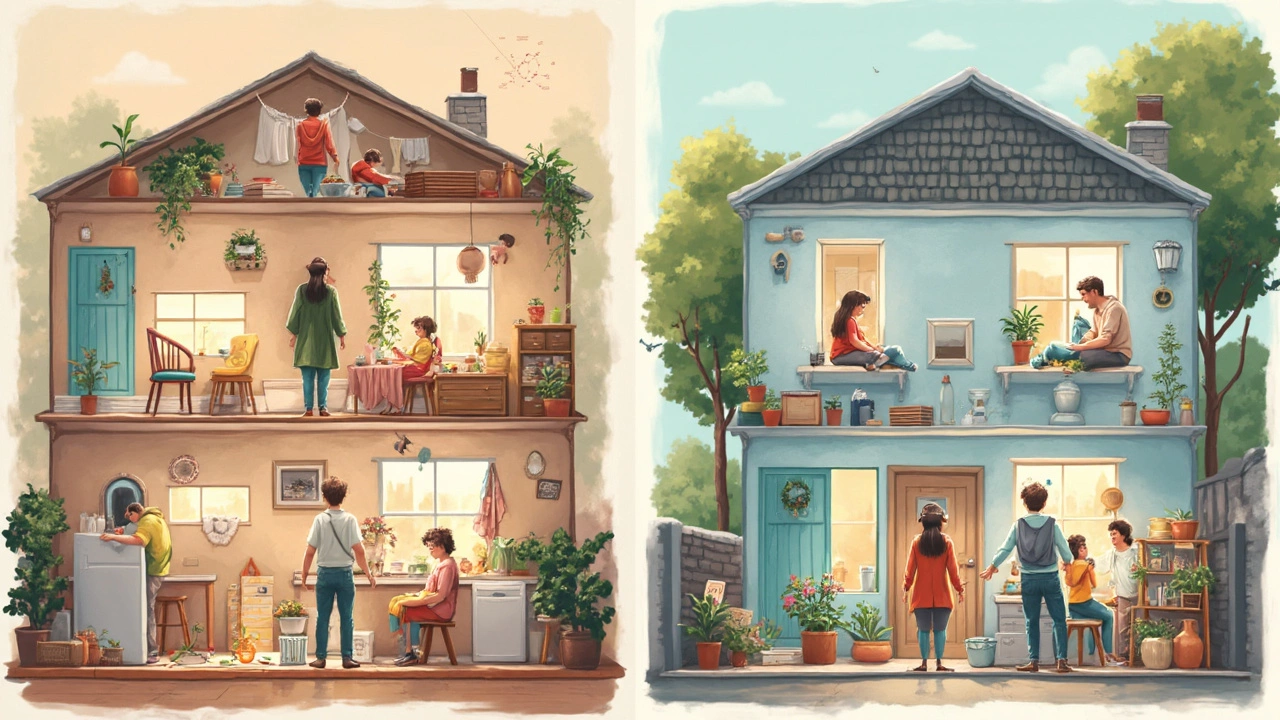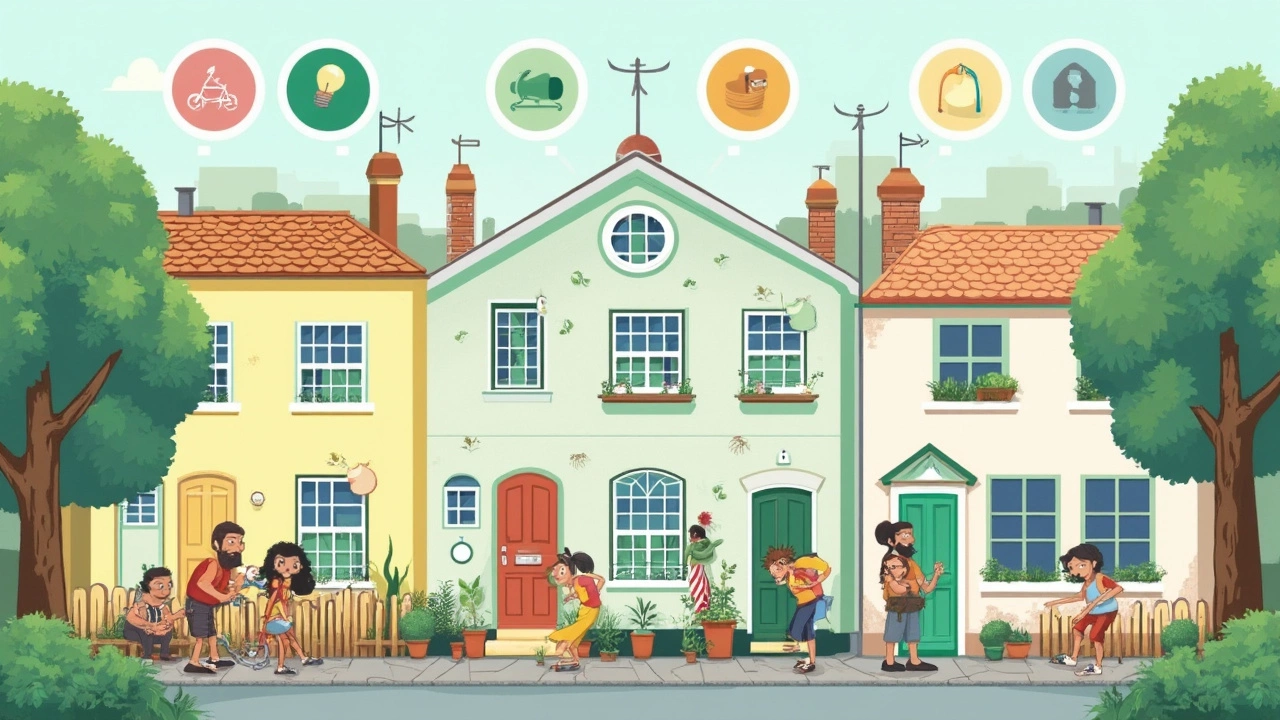Eco-Friendly Living: Is an Apartment or House Better for the Planet?
 May, 17 2025
May, 17 2025
Ever catch yourself wondering whether your home is helping or hurting the planet? The whole "apartment versus house" debate hits hard, especially if eco-living is your thing. The answer messes with expectations—a big fancy house isn’t always the clear villain, but size really does matter when it comes to energy and resources.
Think about it: stacked apartments share walls, ceilings, and floors. That means fewer outside surfaces for heat and cold to sneak in or out. Less space to fill with stuff. More people using one patch of land. It’s not just about your monthly energy bill—it’s about the resources sucked up from the day the building went up. But is that the full eco-story? Not quite. There’s a lot to unpack when you look at things like water use, trash, and those daily routines we never think about.
If you care about making a real difference (without giving up all your comforts—looking at you, long showers), digging into the details can help. Stick around to learn where you can easily shrink your eco-footprint and what features make some homes greener than they look.
- Space and Resources: Who Uses More?
- Heating, Cooling, and Energy Costs
- Water Use and Waste
- Daily Habits: Little Things Add Up
- Cottages and Planet-Friendly Living
Space and Resources: Who Uses More?
When it comes to eco-friendly living, the size and setup of your home can totally change your impact. Here’s the deal: the average single-family house in the U.S. is about 2,300 square feet, while the typical apartment sits around 940 square feet. Less space almost always means less stuff, less energy, and fewer resources needed—makes sense, right?
Shared apartments end up being way more efficient with land and building materials. When people live closer together, they use less land per person and the construction process becomes less wasteful. You’re not duplicating big lawns, endless driveways, or that random extra bathroom nobody ever uses.
| Home Type | Average Size (sq ft) | Estimated Annual Energy Use (kWh) | Average Residents |
|---|---|---|---|
| House | ~2,300 | ~11,000 | 2.5 |
| Apartment | ~940 | ~6,000 | 2.1 |
Houses often come with yards—which sound great until you start thinking about mowing, watering, and fertilizing. Maintaining a patch of grass or a big patio can eat up a surprising amount of water and gas. Apartments, especially in cities, might swap big lawns for shared green spaces or even rooftop gardens.
Look at it like this: the more square footage, the more you spend heating, cooling, lighting, and filling up with furniture. Smaller spaces nudge you toward a simpler (and usually greener) lifestyle. If you want to use less and waste less, living smaller, whether that’s in a cozy eco-cottage or an apartment, just makes sense.
Heating, Cooling, and Energy Costs
This is where the rubber hits the road for eco-friendly living. The size and setup of your home have a massive impact on energy use. Apartments almost always come out ahead because they’re bundled together, sharing walls, ceilings, and sometimes even floors. That shared space cuts down on heat loss in winter and leaks of cool air in summer. Basically, it takes less energy to keep an apartment comfortable.
According to the U.S. Energy Information Administration, the average apartment in the U.S. uses less than half the energy per square foot compared to a detached house. One simple reason? It’s much easier (and cheaper) to heat or cool a smaller, shared unit than a big, stand-alone place with four exposed walls and a roof just for you and your cat (hi, Mistral!).
| Avg. Annual Energy Use (kWh) | |
|---|---|
| Apartment (under 5 units) | 7,300 |
| Detached House | 12,700 |
Of course, things like insulation, window quality, and your own habits matter too. Some modern houses use fancy heat pumps or super-thick insulation, and that can really shrink their energy bills. But let’s be real—few people can afford to do a big energy retrofit overnight.
- If you rent, check if your building uses efficient systems or if you can add weather stripping to windows and doors.
- Use heavy curtains to keep out sun in summer and hold in warmth in winter. Old-school move, but it works.
- Switch to LED bulbs and unplug stuff you’re not using. Even chargers suck tiny amounts of power all day.
The takeaway? The eco-friendly winner is usually the apartment, just because it uses less space, less exposed surface, and way less energy per person. If you’re in a house, small changes still add up, so don’t get discouraged. Even a little effort can slash your energy use big time.

Water Use and Waste
If you’ve ever tried to lower your water bill, you know it can be a challenge—especially depending on where you live. Apartments and houses use water in totally different ways. In a typical U.S. apartment, the average water use is about 100 gallons per person per day. Single-family houses? It often jumps closer to 130 gallons, and that doesn’t even count all those thirsty lawns and gardens.
Yard size really makes a difference. Lawns suck up more water than almost anything else at home. Apartment dwellers usually skip the yard work (and save a ton of water in the process), but house owners can cut way back by swapping grass for native plants or using drought-resistant landscaping—sometimes called xeriscaping.
Waste is another spot where apartment living tends to have the edge. Shared dumpsters and recycling bins are pretty standard, so there’s usually a decent system in place. Houses sometimes make this harder; you manage your own bins, so it’s easy to forget about composting or recycling if you’re not in the habit.
Want some quick ways to use less water and cut waste?
- Install low-flow showerheads and toilets. (Don’t worry, they still work just fine—your shower will still feel like a real shower.)
- Fix leaks fast—one drippy faucet can send hundreds of gallons down the drain each year.
- Only run laundry and dishwashers with full loads. It’s good for your wallet and the planet.
- If you have a house, collect rainwater with a barrel for plants—it’s free and way better than hose water.
- Compost food scraps, even in small apartments (you’d be surprised what you can do with a countertop bin or a community compost drop-off).
Of course, your daily habits matter as much as where you live. Whether you’re in an apartment or a house, being mindful of water use and keeping your waste in check goes a long way. Tiny changes really do add up.
Speaking of habits, if you’re serious about staying eco-friendly, it’s these little routines—like shorter showers or composting—that end up making the biggest difference over time.
Daily Habits: Little Things Add Up
Where you live matters, but what you do every day at home makes a massive difference for the environment. You could put two people in identical apartments and see totally different impacts based on how they use energy, water, and everything else. Actually, according to the U.S. Energy Information Administration, nearly 30% of home energy use comes from just heating and cooling, but the rest—stuff like cooking, showering, lighting, and electronics—really piles up too.
Here’s where your habits stack up, no matter if you’re chilling in a leafy cottage or perched in a city apartment:
- Eco-friendly lighting like LEDs can cut your lighting energy use by up to 75% compared to old-school bulbs. Easy win.
- Short showers and low-flow showerheads can save up to 2,700 gallons of water per person, per year. That’s three months’ worth of daily baths gone in one quick switch.
- Unplugging gadgets and using smart power strips keeps “vampire power” from quietly eating energy. The Department of Energy says wasted standby power can make up as much as 10% of your monthly electricity bill.
- Recycling and composting keep up to 40% of household waste out of landfills. Even apartment dwellers can set up countertop compost bins or join local collection programs—my cat Mistral hates the food scraps but the garden loves them.
- Avoiding single-use plastics and opting for reusable bags, bottles, or containers can shrink your trash and your carbon footprint without much hassle.
Let’s look at how these small choices actually add up over a year for a typical household:
| Habit | Annual Savings (per household) | Why It Matters |
|---|---|---|
| Switching to LED lights | $75 (plus 400 lbs. less CO₂) | Less energy needed for lighting, lower bills |
| Shorter showers | 2,700 gallons water | Reduces water bills and strain on local supply |
| Unplugging electronics | $100 | Cuts out hidden energy waste |
| Recycling and composting | About 1,000 lbs. waste diverted | Keeps trash out of landfills, reduces methane |
| Reusable shopping bags | ~500 fewer plastic bags | Lowers plastic pollution |
Does one eco-habit wipe out the cost of old appliances and big spaces? Not always, but these daily choices stack up if everyone pitches in. Even cooler, a lot of apartments and new cottages now have built-in features for composting, recycling, and smart energy use—so you barely even have to think about it. If you want your home (and the planet) to be a little happier, it really does start with those small, easy changes.

Cottages and Planet-Friendly Living
Cottages can seem like the gold standard if you dream about cozy, green living. But do they really outshine apartments or houses for the eco-minded? The answer depends a lot on size, building materials, and what you do inside those four walls. Smaller spaces, like cottages, naturally use less energy. Less to heat, less to cool, and fewer lights to leave on by mistake. But traditional cottages weren’t always built with modern sustainability in mind.
Smart eco-cottage living is about more than just square footage. It’s about insulation, local materials, and how you manage water and waste. For instance, a well-insulated cottage will cut heating and cooling needs by at least 25%. There are even cottage communities today that focus on shared resources, like gardens or rainwater collection, which can seriously shrink your overall impact.
- Choose materials like reclaimed wood or recycled insulation. These chop down the environmental cost of construction.
- Use solar panels or heat pumps. Renewable energy isn’t just for the city—it works just as well in a cottage (plus, there are tax breaks in many areas).
- Collect rainwater for your garden or even your toilet. A simple barrel setup can save thousands of liters a year.
Want to see how cottages stack up next to apartments and houses for eco-impact? Here’s a look at some real numbers:
| Type | Average Floor Space (sq ft) | Annual Energy Use (kWh) | Water Use per Person (liters/day) |
|---|---|---|---|
| Modern Eco-Cottage | 700 | 4,200 | 100 |
| Average Apartment | 900 | 5,600 | 130 |
| Detached House | 2,000 | 12,000 | 160 |
Just because a cottage is small doesn’t automatically make it green. If you pick the right upgrades and get smart about your resource use, though, it’s a great move for lower-impact living. And if you’re into the whole social vibe, lots of eco-cottage communities offer ways to share land, gardens, and even tools. That’s eco-friendly in more ways than one.
The big takeaway? Whether you’re in a city apartment, suburban house, or snug cottage, your choices matter most. But a eco-friendly cottage—done right—can definitely compete with, and sometimes beat, the alternatives.